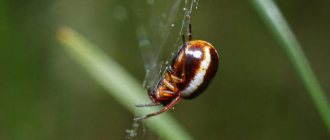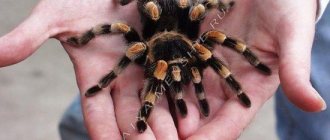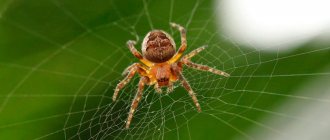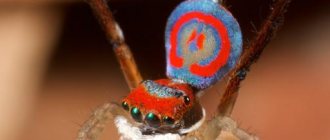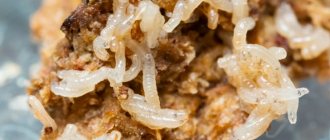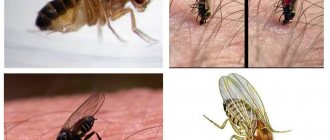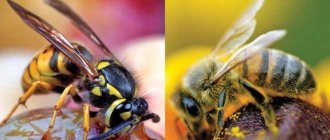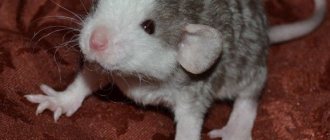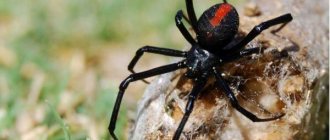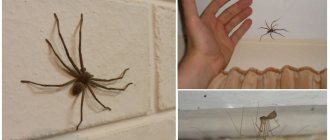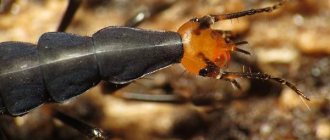Nutrition method
Many people are interested in how spiders eat insects, small vertebrates and other creatures, or rather, how they catch the prey and what they then do with it.
Arachnids are known to weave webs from spider webs, which they use for fishing. The predator itself sits on the central area of the net and waits until it catches an insect. But he determines its presence by the vibration or vibration of the web. The behavior of predators may differ - some can envelop the prey in a web and wait until it stops moving, others attack it immediately. But initially, a toxic substance is injected into the trapped insect.
Spider nutrition has some features:
- they lack complete digestive organs. The food is digested from the outside, after which the insect absorbs the liquid mass through the mouth.
- Carnivores have no teeth in the oral cavity. They grind food using chelicerae, pedipalps similar to tentacles.
- Some spiders can only suck up liquid food, others crush the shell and bite through the skin.
- Digestion of amphibians and rodents takes longer. The predator eats a mouse, frog, or snake gradually, it turns the victim over, constantly injecting a new portion of saliva.
Appearance
The color of the recluse spider depends on its habitat (it is important for it to mimic the surrounding terrain). The body and paws can be the following shades:
The body and paws can be the following shades:
- brown;
- dark brown;
- green;
- red (live in Hawaii);
- dirty yellow.
On the joints of the legs the color is lighter. On the back of the recluse spider there is a spot in the shape of a violin (the neck is directed towards the back), which is why it is nicknamed the “violin spider”. There are only 3 pairs of eyes on the head: one in front, two on the sides.
The length of the recluse spider reaches 10-20 mm, the leg span is 25 mm. The cephalothorax is rounded, the abdomen is dark, elongated. Paws are thin, widely spaced. For this build, the spider received another nickname - “haymaker”.
Araneus spider
Cross spider
Crossworts are members of the orb weaver family (Araneidae). They belong to the contract web spiders. They have an egg-shaped convex abdomen, on which there is a pattern in the form of a cross. Body color ranges from gray to red. They are covered with long bristles, sparsely distributed throughout the body and densely covered with short, thin hairs. Body length in males is 10-11 mm, in females – 17-40 mm. About 30 species of crosses live in the CIS and Russia. These spiders are active in the evening. They deftly weave webs that catch many small insects. Mating and egg laying occurs in the fall. The female lays eggs in a web cocoon and hides it under the bark or other secluded place. In the spring, spiderlings emerge from the cocoon. By the end of summer, a new generation of spiders grows up, and their mother dies. The cross spider is poisonous, but it is not dangerous to humans. Its bite is painful, but the burning and swelling at the site of the bite goes away after a few hours.
The largest spiders
There are more than 40 thousand species of spiders in the world, which differ in size and color, but in appearance they are all almost the same. Among such a variety of species, there are both very small spiders and large ones, reaching 10 cm in size, or even more.
If many species eat small insects, then there are species that feed on small rodents, birds, etc. Some species pose a mortal danger to human health due to their strong poison. For those who are planning to travel or want to get a spider, it is worth knowing what the largest spiders in the world look like.
Goliath tarantula
The tarantula spider “Goliath” from the tarantula family rightfully takes first place in the ranking of “monsters” representing arachnids. This is the largest spider in the world! The animal weighs at least 200 grams, and its size is at least 30 centimeters, including outstretched paws. Lives in the jungles of South America.
The body coloring is many tones of brown, and on the limbs you can see the characteristic white stripes placed across the limbs. Prefers to live in places with high humidity.
Lives in the ground, in burrows up to half a meter deep. Presents a rather aggressive appearance. In case of aggression, it makes peculiar frightening sounds and also shakes off a toxic substance from its hairs, which, compared to its poison, poses the greatest danger to humans.
Theraphose Blond
Some researchers claim that the largest spider in the world is Teraphosa Blonda. This spider is capable of hunting toads, mice and even small snakes. The largest spider of this species was found in 1965 in Venezuela and the span of its limbs was 28 centimeters.
As for the body size, it averages 8–9 cm, and the average span of the spider’s limbs is about 25 cm. These giants live in the forests of Suriname, Venezuela and northern Brazil. Theraphosa Blonde was first described by the French entomologist Latreille in 1804.
Giant crab spider
The giant crab spider is a member of the side-walker family. Also known as the Golden Huntsman Spider. This is one of the largest spiders in North America; its body fits in the palm of your hand, not counting its legs (along with its limbs, about 30 centimeters).
The legs and cephalothorax are sandy brown and covered with short hairs. The tips of the legs are darker. The abdomen is round, slightly smaller than the cephalothorax. A narrow dark stripe runs down the center of the abdomen and ends with a dot.
Giant crab spiders are ambush predators, lying in wait on vertical surfaces for anything smaller than themselves. Despite their large size and supposed weight, they are incredibly fast. Lightning fast speed and jumping ability allows them to successfully catch prey
It is poisonous, but the poison is not fatal to humans, although manifestations of intoxication of the body are possible in the form of severe headache, nausea, vomiting, as well as severe swelling at the site of the bite. Therefore, it is better not to meet such a monster. The color of this species can be varied.
Brazilian pink tarantula
Another giant is the terrestrial pink Brazilian tarantula of the New World. The species is said to be the third or fourth largest tarantula in the world, growing anywhere from 25–28 cm, with most having a diagonal leg span of only about 22–25 cm.
The Brazilian pink tarantula is a very fast-growing spider that can reach adult size in just 2 years and has a lifespan of about 15 years. Females can produce sacs containing 1,200 to 3,000 eggs.
Although this tarantula is large, its venom is not medically significant, so the fangs are potentially more painful than the venom.
Camel spider
This class of arachnids represents the order of phalanges and has at least 1 thousand species. This type of giant spider is called differently in different scientific works. The body is about 7 cm in size, and together with open paws its size is almost 30 centimeters. This species is found on all continents, with the exception of Australia.
Due to the fact that he has something like humps on his head, he was called a camel. The body is distinguished by a brownish-yellow hue, and its paws are covered with long bristles. As a rule, it goes hunting in the dark to catch small rodents, lizards, birds and insects.
These spiders can also attack humans, and they move at speeds of up to 16 km per hour, so it is almost impossible to escape from him. Not poisonous, but their bites are quite painful.
In addition, if leftover food gets into the human body, a person can get blood poisoning. The bite site should be immediately treated with an antimicrobial agent, and antibiotics should also be taken.
What and how to feed a tarantula spider
Despite their name, tarantula spiders do not feed on birds. However, they require live food - zoophobass larvae, crickets, cockroaches. The most popular food is large Madagascar, Bolivian or marbled cockroaches. A tarantula's food should be at least half its size.
For cockroaches you will have to provide a separate container. They eat food from your table. Do not purchase too many units of food - cockroaches will multiply quickly, and the spider consumes them slowly. It is enough to give him food 1-2 times a week; it is more convenient to do this with tweezers. Many tarantulas eat much less frequently - once every 1-3 months. There is no need to panic if your pet refuses food for a long time.
You can tell that a spider is full by its enlarged abdomen. If it becomes 2-3 times larger, then it’s time to stop. Losing interest in food is also a sure sign. After eating, food debris and waste products of the tarantula should be removed.
What should not be offered to a tarantula as food:
- food from your table;
- insects caught on the street - to avoid infection with any disease;
- vertebrates - with the exception of very large spiders.
The tarantula also needs a drinking bowl, into which you regularly add fresh water. Any container or saucer pressed into the ground is suitable as a drinking bowl.
Features of behavior
Side-walking spiders do not spin webs, but use webs to move around. Gusts of wind can throw spiders over long distances. From the outside, it creates the illusion that the spider is flying freely through the air.
In autumn, in one day they are able to migrate several kilometers. For arachnids this is a significant distance. To stop, the sidewalker sheds a web that clings to plants that act as a brake.
At the sight of prey, the hunter straightens his front paws, preparing for a deadly embrace. A certain subspecies of sidewalkers, Thomisidae, are born actors. Sensing danger, they fall feet up and pretend to be dead, deceiving their opponent.
The sidewalker is capable of attacking an insect several times its size. The arthropod eats four average bees in 1 hour.
The reproduction of these spiders has a number of interesting features. Most males of this species are stenochronous, i.e. have one copulation period per year, while female representatives are eurychronous - they reproduce throughout the summer.
Males search for females in different ways. Some court the female, while others sneak up on her unnoticed. The fact is that females have much worse vision than males.
Anyone who approaches her risks becoming her lunch. But even if the spider likes her boyfriend, she will still taste him. A large proportion of spiders after copulation become food for females. While the female is busy, the male can quickly fertilize her and run away.
Before the birth of the offspring, the spider carefully guards its larvae. After birth, babies are not independent - they are still protected and fed by their parents.
Males have even developed a technique with which they fertilize the female in such a way as to have time to escape from her. Arthropods block the forelegs of their partner with a web in order not to be paralyzed by her poison.
The benefits of this type of arthropod for rural areas are known. They eat many pests, but try not to bite people.
The main diet of the sidewalker is flies, which often act as pests for people, carrying a large number of dangerous bacteria.
The food turns out to be garden pests: the Colorado potato beetle, moths, bedbugs. Spider venom is sometimes used as a pesticide.
Is the bite of Argiope Brünnich dangerous for humans?
Like other representatives of arthropods (wolves, spiders and tarantulas), the wasp spider is a carrier of poison. Otherwise, he would not be able to obtain food for himself by hunting small arachnids and insects. But the striped predator is not dangerous for humans, although it can frighten particularly impressionable people with its appearance.
A wasp spider can bite a person only in exceptional cases when that person directly threatens his safety. For example, he squeezed a spider in his hand and tore off its web. But even then the arthropod creature will try to pretend to be dead so as not to aggravate the situation. The trick won't work - it will bite.
The consequences of a bite depend on the age and allergic vulnerability of the person. In any case, they will not cause significant harm to health. However, it is better to stay away from spiders of the Argiope family. Let them live in the forest, on green grass, and not in a summer cottage or flower garden.
Habitat
The argiope spider prefers a warm climate to live, but is also found in the northern regions. Most often it can be seen in the steppes and deserts.
Lives in Central, Southern Europe, North Africa. Found in Asia Minor, Central Asia, Korea, Japan, China, India, Kazakhstan, Crimea, and the Caucasus. In Russia, it settles in the Penza, Oryol, Lipetsk, Tambov, Voronezh, Ulyanovsk, Saratov, Moscow, Ryazan, and Tula regions.
Most often, argiope settles on roadsides, meadows, fields, and forest edges. Weaves its web between the leaves of bushes. For life, it prefers warm areas open to sunlight.
Tolerates both dry weather and high humidity. It is not afraid of people, so it is found near dwellings. Often seen in gardens and orchards. Rarely wanders into premises.
Spider Reproduction
As spiders grow, from time to time they shed their tight chitinous shell and acquire a new one. They can molt up to 10 times in their entire life. Spiders are dioecious, with the female being much larger than the male.
During the mating season, which lasts from mid-autumn to early spring, the male fills the bulbs located at the ends of his pedipalps with sperm and goes in search of a female. After performing the “mating dance” and fertilization, the male spider hastily retreats and dies after some time.
After two and a half months, the female spider lays eggs, and after 35 days small spiderlings appear, living in the web until the first molt. Females reach sexual maturity at 3-5 years of age.
Among spiders, only poisonous ones pose a danger to humans. In the CIS countries there is one such species - the karakurt, or black widow. With a timely injection of a special serum, the bite goes away without consequences.
White Demon
But the next creature is not to be trifled with. Those who travel to Africa and South America have a chance to meet him. This large black and white spider is characterized by aggressive behavior, and its venom is toxic to humans. The species Heteroscodra maculata is not among the most dangerous spiders, but its bites are painful and require medical attention. The spider's venom quickly spreads throughout the body and can cause a lot of trouble.
The leg span of this creature reaches 15 cm. Its body is covered with hairs that make it look like a fur toy. But this impression is deceptive - before you is a formidable opponent. Contact with him should be avoided.
Interesting facts about spiders
- According to statistics, 6% of the world's population suffers from arachnophobia - the fear of spiders. Particularly sensitive people panic when they see a spider in a photo or on TV.
- Frightening-looking tarantula spiders, with a paw span of up to 17 cm, are actually calm and non-aggressive, thanks to which they have earned the reputation of being popular pets. However, owners must protect their pets from stress, otherwise the spider sheds its bright hairs, which cause an allergic reaction in humans.
- The most poisonous spiders are considered to be black widows, their variety is karakurt, as well as Brazilian soldier spiders. The venom of these spiders, containing powerful neurotoxins, instantly attacks the victim's lymphatic system, which in most cases leads to cardiac arrest.
- Many people mistakenly believe that tarantula venom is fatal to humans. In reality, a tarantura bite causes only a slight swelling, similar to a wasp sting.
- Wall crab spiders, named Selenopidae in Latin after the Greek goddess of the Moon, move sideways as well as backwards.
- Jumping spiders are excellent jumpers, especially over long distances. As a safety net, the spider attaches a silk web thread to the landing site. In addition, this type of spider can climb glass.
- When chasing prey, some species of spiders can run almost 2 km in 1 hour without stopping.
- Fishing spiders have the ability to glide across water like water striders.
- Most species of spiders have an individual form of woven web. House (funnel) spiders weave funnel-shaped webs; dictine weaver spiders are characterized by angular webs. The web of Nicodam spiders looks like a sheet of paper.
- Lynx spiders are distinguished by a property that is uncharacteristic of spiders: to protect the clutch, females spit on the threat of poison, although this poison does not pose a danger to humans.
- Female wolf spiders are very caring mothers. Until the children gain independence, the mother “carries” the cubs on herself. Sometimes there are so many spiders that only its 8 eyes remain open on the spider’s body.
- The New Zealand cellar spider was immortalized in cinema thanks to director Peter Jackson, who used this species as the prototype for the spider Shelob.
- Very beautiful flower spiders lie in wait for prey on flowers, and adult females, as a camouflage, change their color depending on the color of the petals.
- The history of mankind is closely intertwined with the image of the spider, which is reflected in many cultures, mythology and art. Each nation has its own traditions, legends and signs associated with spiders. Spiders are even mentioned in the Bible.
- In symbolism, the spider personifies deceit and immeasurable patience, and the spider’s venom is considered a curse that brings misfortune and death.
Benefits of the cross spider for humans
Despite the fact that spiders can inject poison into the human body and pose a danger, their web has useful properties and can be used in various fields.
Spider web has an excellent antibacterial effect, so it can be used to disinfect wounds.
In optical instruments where ultra-precision in calculations is needed, the web of this spider is used.
Microbiologists made a discovery and developed a unique air analyzer based on the crusader's web. It is the web that catches all microparticles
, which are in the air, and the composition of the air is determined from them.
Cross spiders are unique animals that can be useful to humanity.
The cross spider catches its prey using a web. The spinning apparatus of spiders consists of external formations - arachnoid warts - and internal organs - arachnoid glands. Three pairs of arachnoid warts are located at the posterior end of the abdomen. Each such wart is pierced at the end with hundreds of tiny holes. From each hole flows a drop of sticky liquid, which, when the spider moves, is pulled out into the thinnest thread. These threads merge into one and quickly thicken in the air. The result is a thin but strong thread. This sticky liquid is secreted by numerous arachnoid glands located in the back of the abdomen. Their ducts open on arachnoid warts.
To form its trapping net, the cross spider first attaches a thread in several convenient places, forming a frame for the net in the form of an irregular polygon. Then it moves to the middle of the upper thread and, going down from there, draws a strong vertical thread. Then, from the middle of this thread, as if from the center, the spider draws the threads in all directions, like the spokes of a wheel. This is the basis of the entire web. The spider then begins to draw circular threads from the center, attaching them to each radial thread with a drop of adhesive. In the middle of the web, where the spider itself then sits, the circular threads are dry. Other threads are covered with droplets of a very sticky liquid and are therefore always sticky. There are over 100,000 such droplet knots in this network. Insects that fly onto the net stick to them with their wings and paws. The spider itself either hangs head down in the center of the web, or hides to the side under a leaf. In this case, he extends a strong signal thread towards himself from the center of the web.
When a housefly gets into the net, the spider, sensing the trembling of the signal thread, rushes out of its ambush. By piercing its claws with poison, the spider kills the victim and secretes digestive juices into its body. After this, he entangles the fly or other insect with a web and leaves it for a while.
Under the influence of secreted digestive juices, the internal organs of the spider's victim are quickly digested. After some time, the spider returns to the victim and sucks out all the nutrients from it. All that remains of the insect in the web is an empty chitinous cover.
Making a fishing net is a series of interconnected unconscious actions. The ability to perform such actions is instinctive and is inherited. This can be easily verified by observing the behavior of young spiders. When they emerge from their eggs, no one teaches them how to make a catching net, but the spiders immediately weave a web correctly.
Lifespan
Phrynes are long-lived compared to their relatives. Under natural conditions, they can live from 8 to 10 years. And in captivity, with the necessary care, they can live up to 12 years.
Individuals reach sexual maturity by three years. During this period, they can already begin mating games, mating, and laying eggs.
During the mating season, competitions begin among males in which they fight for the attention of the female, the loser leaves the battlefield
The Phryne spider is an interesting representative that has a terrifying appearance, but at the same time a completely non-aggressive disposition. Arthropods are striking with their long, rope-shaped limbs and unusual body structure, which is why they are often used as pets.
Black Widow Identification
The size and appearance of male and female spiders differ from each other. The female is larger, its size, excluding legs, ranges from 8 to 13 mm, and its weight averages about 1 gram.
Black widow, Latrodectus mactans, distinguished from other species by a red spot on the abdomen in the shape of an hourglass
An adult female has a more rounded and voluminous body compared to the male. The color is glossy black, with a red, hourglass-shaped spot on the belly that serves to warn off predators. Sometimes there may be a stripe consisting of irregular red spots appearing on the upper body.
The male's body is smaller, with the exception of the legs, measuring from 3 to 6 millimeters. The body is elongated, on the side of the abdomen there are 4 pairs of white and red stripes. Young males are mostly white, orange and brown. They become darker in color as they mature.
Spiders are arthropods. Protection of the body from small predators is provided, like all spiders, by a shell that constantly changes during the molting process. During molting, the spider is more vulnerable.
The spider has 8 eyes, which are arranged in two horizontal rows of 4. The pair of eyes in the center of the bottom row is considered primary, and the rest are considered secondary.
Argiope Brünnich spider: poisonous or not?
The question of the potential danger of the entire crawling brethren worries people in the first place. Argiope Brünnich did not escape a similar fate. Whether this species of spider is poisonous or not is incorrect to ask. Strictly speaking, all arachnids are poisonous; another thing is that not all representatives of the species are able to bite through the skin enough for their poison to reach at least the capillaries. So, even without conducting laboratory tests, we can say with confidence that Argiope Brünnich is a poisonous insect. In the end, it is with poison that she “pacifies” her victims. And it is fatal to insects. Another thing is the person. Its dimensions are not comparable to those of Argiope Brünnich. The bite of this spider is therefore relatively harmless to humans. It can be compared to being stung by a wasp (the spider lives up to its middle name). The sensation is quite painful, and swelling and itching may subsequently occur, but an argiope bite does not pose any danger. Only an allergic person can suffer from it. But the same troubles will be brought to him by the bite of any insect, even a mosquito.
Wasp Spider,
or
Bruennichi's argiope (
Argiope bruennichi )
is an arthropod that belongs to the class Arachnida, order spiders, suborder Opisthothelae, infraorder araneomorphic spiders, superfamily Araneoidea, family orb-weaving spiders, subfamily Argiopinae, genus Argiope.
International scientific name: Argiope bruennichi
(Scopoli, 1772).
The species name for the spider was given in honor of Morten Trane Brünnich, a zoologist from Denmark. Due to its warning coloration with black and yellow stripes, this representative of arachnids is often found under the name wasp spider, and in some countries it is called the tiger spider or zebra spider. Some people incorrectly call it the bee spider.
On the fourth stripe from the cephalothorax, two small tubercles are clearly visible.
The male wasp spider is inconspicuous, does not look like a wasp at all and is painted in a light beige color, on which 2 longitudinal dark stripes are barely visible.
The wasp spider has 6 pairs of limbs: 4 pairs of walking legs, 1 pair of chelicerae (jaws) with movable claws, with which the striped spider grabs prey, and 1 pair of pedipalps, which perform the function of touch.
In individuals of both sexes, the legs are long and thin, brownish in color. The limbs of females are decorated with alternating bright dark and light rings, very similar to stockings. In males, the rings on the limbs are faded and blurred. Large bulbs, their reproductive organs, are clearly visible on the pedipalps of male wasp spiders.
The respiratory organs of the wasp spider are represented by a pair of lungs and trachea, opening with one spiracle in front of the arachnoid warts.
Do Argiopes bite?
Any spider can bite, and a tiger spider is no exception. The bite of the Argiope Brünnich spider is not capable of causing serious harm to human health, but unpleasant consequences are possible. In terms of the body's reaction, it resembles a wasp sting. A spot and a small tumor forms around the wound.
You should beware of the bee spider, as it has quite strong jaws. They can inflict a deep wound into which a non-lethal, but still poison, will enter and cause dangerous symptoms. Allergy sufferers and children with an immature immune system are especially sensitive. Severe itching, burning, swelling, possibly nausea and dizziness are good reasons to consult a doctor. Most people experience mild pain that goes away within an hour or two.
The yellow butt spider will not bite unless it is in danger. Just don’t touch its web, admire the animal’s unique coloring from the side and leave it alone with its worries.
Interesting facts about the bird
- A distinctive feature of the species is its strong voice. Singing reaches a volume of 90 dB. This is equivalent to a running vacuum cleaner or a moving tram. Multi-tonal trills last 5-6 seconds. Their vibrant songs with a frequency of 4000-9000 Hz can be heard at a distance of 500 meters.
- Gender cannot be determined by color. During the breeding season, females develop a brood spot and the cloacal protuberance enlarges. Males do not incubate the brood. The male also differs from the female in habits. Males are more active and make a lot of sounds, while females are more secretive and sing extremely rarely.
- Males are unusually polygamous. While their companion evaporates the offspring, they calmly look for a new mate.
- The image of this tiny bird adorned the British farthing minted from 1937 to 1956.
- The ancient Celts and Welsh considered the bird sacred. She is still revered in many European countries: England, Ireland, Iceland. The wren is a frequent character in folklore and literary works.
Varieties of wolf spider
There are more than 2 thousand species of poisonous wolf spider families. They are divided into 116 genera. Species may have some differences in terms of hunting - running or weaving webs, nocturnal or daytime activity. To a greater extent, all varieties live in the tropical climate zone. But more and more representatives of this species are appearing on Russian territory.
Apulian tarantulas
Occurs most often. The insect is large, measuring more than 7 centimeters in length. Lives near the slopes of mountains and hills. It hides in fallen leaves and uses them to cover its burrows. The tarantula's bite is painful and was previously considered poisonous. But scientists managed to invent an antidote.
South Russian tarantula
Another common subspecies. It is smaller in size than the Apulian one (does not exceed 3 centimeters), but is considered the largest representative in the CIS. They live in the tropics, but have migrated here too.
Actions to take when bitten by spiders
Any spiders are usually poisonous. There are a great variety of arachnids in the world and some of them are even deadly. But the most common are spiders, whose venom is not very toxic, and its quantity is very small to provoke the occurrence of severe symptoms of poisoning.
In our latitudes, the most dangerous arachnids are karakurts and tarantulas.
Karakurts are rather small, up to two centimeters in length, black spiders with red spots on the abdomen.
Tarantulas are black or dark brown spiders, usually three to four centimeters in length. However, some individuals can reach twelve centimeters. The most characteristic feature of a tarantula is the hairs that cover its entire surface. Moreover, due to their more menacing appearance, tarantulas cause more fear than karakurts, but their bite does not pose a serious danger. The bite of the karakurt is much more dangerous. But at the same time, you should know that spiders do not just attack a person, but bite only if they are disturbed, for the purpose of self-defense.
The spider bite itself is practically painless, and the first symptoms appear only after several hours. These include:
- dizziness and general weakness;
- shortness of breath and rapid heartbeat;
- redness and slight swelling at the site of the bite;
- an hour after the bite, severe pain appears, spreading to the lower back, shoulder blades, abdominal area and calf muscles;
- shortness of breath, nausea and vomiting;
- seizures;
- increase in body temperature up to forty degrees;
- increased blood pressure.
In especially severe cases, sudden changes in emotional state occur - from depression to overexcitement, severe convulsions, severe shortness of breath and pulmonary edema appear. Three to five days after a karakurt bite, a skin rash appears, and weakness and general discomfort are observed for several weeks.
Tarantula venom is much weaker, and it manifests itself as swelling and swelling at the site of the bite, redness of the skin, weakness and drowsiness, apathy, slight pain and heaviness throughout the body.
After a few days, all symptoms disappear.
First aid for any spider bite:
- Treat the bite site with an antiseptic.
- Lay and cover the victim, warm him and ensure complete rest.
- Give a painkiller.
- Give the victim plenty of water.
- If a limb is bitten, it should be tightly bandaged, starting from a distance of five centimeters above the bite, and ensure its immobility. If swelling increases, the bandage should be loosened. The limb must be fixed below the level of the heart.
- If the bite occurred in the neck or head, then the bite site should be pressed down.
- Seek medical attention immediately.
- In a serious condition, if it is impossible to show the victim to a doctor, it is necessary to give a hormonal anti-inflammatory drug.
What not to do if you are bitten by a spider:
- scratching or rubbing the bite site, as this leads to further spread of the poison and contributes to the occurrence of infection;
- make cuts in the bite area;
- cauterize the bitten area;
- suck out the poison, since through any, even the smallest wound in the mouth, the poison penetrates the human blood.
Spider - description, characteristics and photographs
The body of arachnids consists of two parts:
- The cephalothorax is covered with a shell of chitin, with four pairs of long jointed legs. In addition to them, there is a pair of claws (pedipalps), used by mature individuals for mating, and a pair of short limbs with poisonous hooks - chelicerae. They are part of the oral apparatus. The number of eyes in spiders ranges from 2 to 8.
- Abdomen with breathing holes located on it and six arachnoid warts for weaving webs.
The size of spiders, depending on the species, ranges from 0.4 mm to 10 cm, and the span of their limbs can exceed 25 cm.
The coloring and pattern on individuals of different species depend on the structural structure of the integument of scales and hairs, as well as the presence and localization of various pigments. Therefore, spiders can have both dull, monochromatic and bright colors of various shades.
Black widow (Latrodectus mactans)
The black widow, also known as the southern black widow (Latrodectus mactans, English Button spider), is a poisonous spider from the family of web spiders. The black widow was first described in 1775.
The black widow's habitat covers the territory of South Africa. The black widow is quite common in homes and outbuildings. In total, there are six species of black widow in South Africa, each of which is poisonous to humans.
Of the six species of black widow, four species of spiders are black and two species are brown. The black widow has a round belly with slender legs; the third pair of legs of the spider is shorter than the others. The color of the spider can vary depending on the species from black to cream. Markings on the abdomen also vary from stripes to spots. The abdomen of adults has red spots or stripes. On the abdomen of immature females there are red spots with a white rim. The brown black widow has a pattern on its abdomen that resembles an hourglass. The body length of the spider is about 12 mm, the length of the legs is 12 mm. Adult male black widows are half the size of females. Juvenile black widows are white or yellowish-white in color and darken with each molt as they mature. In the process of growing up, spiders experience from 7 to 9 molts. The lifespan of a black widow is between 12 and 18 months.
Female black widows kill the males after mating, which is where the name of the spider comes from. The female spider weaves her web in a funnel shape, usually close to the ground, in bushes or among debris. The cocoon with eggs is creamy white in color. One black widow egg can contain up to 100 small spiders. The small spiders hatch from the eggs within 2-4 weeks. Just like females, small spiders are cannibals. While inside the cocoon, small spiders feed on each other. As a result, from 1 to 12 spiders hatch from one black widow clutch.
The black widow's diet consists of termites, beetles and various small insects.
The venom of a black widow is dangerous to humans; the bite of a black spider is more dangerous than a brown one. The bite of black spider species is very painful and causes profuse sweating, increased blood pressure, cramps and generalized muscle pain, severe weakness in the legs. Despite the lack of mortality statistics from a black spider bite, the risk of death for young children and the elderly is quite high.
A brown spider bite is less painful and causes a burning sensation that can spread to surrounding tissue and lymph nodes. A localized red rash appears around the bite. Recovery after a bite occurs within one to two days.
In case of a bite, the patient must be hospitalized within 24 hours. An effective way to treat a bite is to administer Antivenom (10 ml) intravenously, followed by 5 mm every 4-6 hours. Intravenous administration of calcium gluconate solution can also be an effective remedy against seizures.
